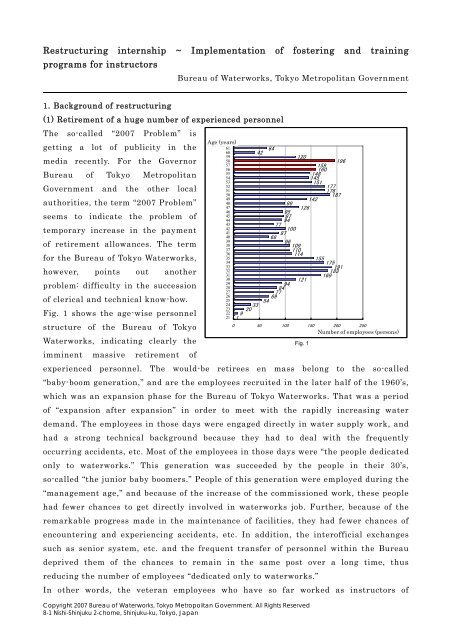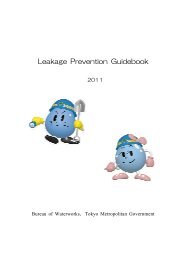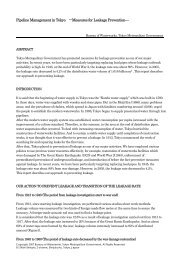Restructuring internship - Bureau of Waterworks Tokyo Metropolitan ...
Restructuring internship - Bureau of Waterworks Tokyo Metropolitan ...
Restructuring internship - Bureau of Waterworks Tokyo Metropolitan ...
Create successful ePaper yourself
Turn your PDF publications into a flip-book with our unique Google optimized e-Paper software.
<strong>Restructuring</strong> <strong>internship</strong> ~ Implementation <strong>of</strong> fostering and training<br />
programs for instructors<br />
<strong>Bureau</strong> <strong>of</strong> <strong>Waterworks</strong>, <strong>Tokyo</strong> <strong>Metropolitan</strong> Government<br />
1. Background <strong>of</strong> restructuring<br />
(1) Retirement <strong>of</strong> a huge number <strong>of</strong> experienced personnel<br />
The so-called “2007 Problem” is<br />
年 Age 齢 ((years)<br />
歳 )<br />
getting a lot <strong>of</strong> publicity in the<br />
61<br />
64<br />
60 42<br />
59<br />
120<br />
media recently. For the Governor<br />
58<br />
196<br />
57<br />
159<br />
56<br />
<strong>Bureau</strong> <strong>of</strong> <strong>Tokyo</strong> <strong>Metropolitan</strong><br />
148 160<br />
55<br />
54<br />
145<br />
53<br />
151<br />
52<br />
177<br />
Government and the other local<br />
51<br />
176<br />
50<br />
187<br />
49<br />
142<br />
authorities, the term “2007 Problem”<br />
48<br />
99<br />
47<br />
126<br />
46<br />
95<br />
seems to indicate the problem <strong>of</strong><br />
45<br />
77 94 97<br />
44<br />
43<br />
42<br />
temporary increase in the payment<br />
100<br />
41<br />
87<br />
40<br />
68<br />
39<br />
96<br />
<strong>of</strong> retirement allowances. The term<br />
38<br />
109<br />
37<br />
110<br />
36<br />
114<br />
for the <strong>Bureau</strong> <strong>of</strong> <strong>Tokyo</strong> <strong>Waterworks</strong>,<br />
35<br />
155<br />
34<br />
175<br />
33<br />
however, points out another<br />
169 183 191<br />
32<br />
31<br />
30<br />
121<br />
29<br />
problem: difficulty in the succession<br />
28<br />
27<br />
26<br />
<strong>of</strong> clerical and technical know-how.<br />
Fig. 1 shows the age-wise personnel<br />
1 9 20 33 54 69778494 25<br />
24<br />
23<br />
22<br />
21<br />
0 50 100 150 200 250<br />
structure <strong>of</strong> the <strong>Bureau</strong> <strong>of</strong> <strong>Tokyo</strong><br />
Number <strong>of</strong> employees 職 員 (persons) 数 ( 人 )<br />
<strong>Waterworks</strong>, indicating clearly the<br />
Fig. 1<br />
imminent massive retirement <strong>of</strong><br />
experienced personnel. The would-be retirees en mass belong to the so-called<br />
“baby-boom generation,” and are the employees recruited in the later half <strong>of</strong> the 1960’s,<br />
which was an expansion phase for the <strong>Bureau</strong> <strong>of</strong> <strong>Tokyo</strong> <strong>Waterworks</strong>. That was a period<br />
<strong>of</strong> “expansion after expansion” in order to meet with the rapidly increasing water<br />
demand. The employees in those days were engaged directly in water supply work, and<br />
had a strong technical background because they had to deal with the frequently<br />
occurring accidents, etc. Most <strong>of</strong> the employees in those days were “the people dedicated<br />
only to waterworks.” This generation was succeeded by the people in their 30’s,<br />
so-called “the junior baby boomers.” People <strong>of</strong> this generation were employed during the<br />
“management age,” and because <strong>of</strong> the increase <strong>of</strong> the commissioned work, these people<br />
had fewer chances to get directly involved in waterworks job. Further, because <strong>of</strong> the<br />
remarkable progress made in the maintenance <strong>of</strong> facilities, they had fewer chances <strong>of</strong><br />
encountering and experiencing accidents, etc. In addition, the inter<strong>of</strong>ficial exchanges<br />
such as senior system, etc. and the frequent transfer <strong>of</strong> personnel within the <strong>Bureau</strong><br />
deprived them <strong>of</strong> the chances to remain in the same post over a long time, thus<br />
reducing the number <strong>of</strong> employees “dedicated only to waterworks.”<br />
In other words, the veteran employees who have so far worked as instructors <strong>of</strong><br />
Copyright 2007 <strong>Bureau</strong> <strong>of</strong> <strong>Waterworks</strong>, <strong>Tokyo</strong> <strong>Metropolitan</strong> Government. All Rights Reserved<br />
8-1 Nishi-Shinjuku 2-chome, Shinjuku-ku, <strong>Tokyo</strong>, Japan
on-job-training (OJT) at each workplace and who were advisors at the time <strong>of</strong> accident<br />
or trouble, are soon going to quit the job and leave the workplace all at a time.<br />
(2) Promotion <strong>of</strong> consignment and deprivation <strong>of</strong> practical experience<br />
The water supply business is not an exception to the big trend <strong>of</strong> the times, i.e. “from<br />
the government to the private sector,” i.e. “what can be done by the private sectors<br />
should be left to them.” In addition to the construction works, etc. that have long been<br />
carried out on contract basis, commissioned works performed by expert minority are<br />
increasing in various fields <strong>of</strong> the water supply business for effective business<br />
operation. Nevertheless, in spite <strong>of</strong> the increasing number <strong>of</strong> commissioned works,<br />
there are some jobs left; for instance the job <strong>of</strong> commission supervision; and, after all,<br />
the <strong>Bureau</strong> <strong>of</strong> <strong>Tokyo</strong> <strong>Waterworks</strong> bears the ultimate responsibility <strong>of</strong> round-the-clock<br />
distribution <strong>of</strong> “safe and high-quality water” to the customers. The capacity to lead, on<br />
the part <strong>of</strong> the staff doing management and supervision <strong>of</strong> the commissioned enterprise,<br />
will become all the more important in the future.<br />
In the supervision <strong>of</strong> a commissioned enterprise the “practical experience” is not an<br />
essential requirement. However, the opinions from the worksite or the reports <strong>of</strong><br />
training courses suggest that the “practical experience” does make a difference. In<br />
other words, the capability <strong>of</strong> an employee to lead the enterprise depends on whether<br />
he/she has practical experience or not. But, with the commissioned works increasing in<br />
number, there are fewer chances for the employees (staff) to perform the job directly in<br />
the workplace, which may lead to the “degradation in the capability <strong>of</strong> leading and<br />
supervising the enterprise on the spot. Hence, the “pseudo experience” in the training<br />
site becomes increasingly important.<br />
2. Measures for restructuring <strong>internship</strong><br />
(1) Drawing up the “Training Plan 2005”<br />
On the basic concept <strong>of</strong> long-term<br />
effective cultivation <strong>of</strong> human<br />
resources, we drew up and<br />
announced the “Training Plan<br />
2005” in December 2003 after<br />
making a thorough review <strong>of</strong> the<br />
training system, etc. Based on<br />
this plan, we restructured<br />
<strong>internship</strong> (practical training<br />
program) for training so as to<br />
provide required ability<br />
depending on the “years <strong>of</strong><br />
experience” in the task the person<br />
is engaged in.<br />
Image <strong>of</strong> <strong>internship</strong> (Engineer) with distinct levels<br />
Goal <strong>of</strong> training<br />
Advanced training course<br />
Ability to lead and cultivate personnel and private enterprise<br />
Intermediate training course<br />
Ability to perform the task by self decision<br />
Lecture<br />
Ability to perform the task as instructed by the supervisor<br />
Intermediate training course<br />
Training for the newly-appointed Lecture Real experience<br />
Lecture Real experience<br />
Basic knowledge about waterworks<br />
1 month<br />
6 months<br />
Copyright 2007 <strong>Bureau</strong> <strong>of</strong> <strong>Waterworks</strong>, <strong>Tokyo</strong> <strong>Metropolitan</strong> Government. All Rights Reserved<br />
8-1 Nishi-Shinjuku 2-chome, Shinjuku-ku, <strong>Tokyo</strong>, Japan<br />
Fig.2<br />
Lecture 座 学<br />
Simulated 擬 似 体 験<br />
experience<br />
Simulated experience<br />
3 years<br />
Concept<br />
Overall control<br />
and response<br />
to trouble<br />
Correspondence<br />
to<br />
Case <strong>of</strong> failure<br />
Case <strong>of</strong> trouble<br />
Clear vision <strong>of</strong><br />
training objective<br />
Target number <strong>of</strong> years<br />
5 years
In restructuring the <strong>internship</strong>, we set the objective as “acquisition <strong>of</strong> the basic ability<br />
required for performing the clerical business <strong>of</strong> the <strong>Bureau</strong> without fault” instead <strong>of</strong> the<br />
conventional objective as “sequential training,” and the programs conventionally<br />
planned and operated by each concerned business department were included in the<br />
<strong>Bureau</strong>-sponsored training program.<br />
Working groups both in clerical and technical fields were organized and after the study<br />
period <strong>of</strong> about a year, a review <strong>of</strong> the training system was made. For technical field,<br />
efforts were made to create an image <strong>of</strong> the role <strong>of</strong> <strong>internship</strong> by distinguishing the<br />
levels respectively for newly-appointed staff and other personnel from beginner class to<br />
advanced class as shown in Fig.2.<br />
During the process <strong>of</strong> study on the restructuring <strong>of</strong> the <strong>internship</strong>, a thorough and<br />
drastic review was made from the standpoints <strong>of</strong> “the clerical and technical abilities<br />
required for steady succession <strong>of</strong> the <strong>Bureau</strong>’s business” and “the methods required for<br />
the steady and effective succession.” As for the “required abilities,” we sorted out all <strong>of</strong><br />
the clerical and technical jobs performed daily by our staff, and ranked the required<br />
minimum level <strong>of</strong> ability to perform the job as “Beginner Course.” Next, in order to<br />
“standardize” the contents and methods <strong>of</strong> training, we made study on them by<br />
cultivating instructors for the training.<br />
(2) Planned implementation <strong>of</strong> training for instructors<br />
In considering the elaborate contents and methods <strong>of</strong> training, we have started planned<br />
implementation <strong>of</strong> a program called “training for instructors” ahead <strong>of</strong> schedule since<br />
FY2004 to train the instructors for <strong>internship</strong>. A total <strong>of</strong> 400 instructors—<br />
234 persons in FY2004 and 166 persons in FY2005—were trained and, on finishing<br />
their training courses, they received the “Certificates” from the <strong>Bureau</strong> Manager. These<br />
people are actively engaged as instructors in the <strong>internship</strong> program that started in<br />
FY2005 after the restructuring. Fig. 3 shows the curriculum for the instructor training<br />
course, composed mainly <strong>of</strong> two major factors, namely “creation and review <strong>of</strong><br />
curriculum and textbooks” and “training on presentation.”<br />
Copyright 2007 <strong>Bureau</strong> <strong>of</strong> <strong>Waterworks</strong>, <strong>Tokyo</strong> <strong>Metropolitan</strong> Government. All Rights Reserved<br />
8-1 Nishi-Shinjuku 2-chome, Shinjuku-ku, <strong>Tokyo</strong>, Japan
Schedules Execution time Days Subjects Contents<br />
General training 1 Around the<br />
0.5 day<br />
・In opening the course<br />
・Importance and significance <strong>of</strong> an instructor<br />
middle<br />
August<br />
<strong>of</strong><br />
・Method <strong>of</strong> proceeding the “Training Course<br />
for Instructors”<br />
・ Instructor’s skill<br />
・Instructor’s role in training<br />
(Introduction)<br />
・ Instructor’s skill (technique) [classroom<br />
lecture]<br />
*Technique introduction is subject to omission.<br />
(Voluntary work)<br />
September ~<br />
Collective<br />
Review <strong>of</strong> textbook<br />
Creation and review <strong>of</strong> the concerned<br />
・ Creation and<br />
November<br />
training:<br />
textbook<br />
improvement<br />
<strong>of</strong><br />
Once<br />
or<br />
2Creation and improvement <strong>of</strong> lecture<br />
textbook<br />
twice<br />
a<br />
plan (lesson plan)<br />
・ Preparation <strong>of</strong><br />
month<br />
lecture plan<br />
* Each instructor shall make a review on the subject he/she is in charge <strong>of</strong> before making adjustment after<br />
getting together in groups.<br />
Power point training October ~ 1 day Power point ・Preparation <strong>of</strong> sheet<br />
(Applicants only) December<br />
・Slide-show playing<br />
・Animation setting<br />
Instructor technique October ~ 2 days Teaching method Effective presentation and method <strong>of</strong><br />
(Compulsory)<br />
December<br />
giving lecture<br />
General training 2 February 0.5 day Cultivating human ・General lecture (Enhanced motivation <strong>of</strong><br />
resources<br />
would-be instructors)<br />
・Awarding the “Certificate for Instructor”<br />
Fig. 3<br />
1 Selection <strong>of</strong> candidates for instructor training course<br />
Officials <strong>of</strong> the levels <strong>of</strong> Assistant Section Chief and Chief Clerk have so far been<br />
appointed as “pinch hitters” for training the instructors instead <strong>of</strong> the full-time staff <strong>of</strong><br />
a Training Department, with the instructors for training involving skill confined only to<br />
specific staff.<br />
After making a thorough study <strong>of</strong> the aforesaid background as well as <strong>of</strong> elaborate<br />
contents and methods <strong>of</strong> training during the training course for instructors, we decided<br />
to choose experienced staff “working in the front line in the site” and “well versed in<br />
the business” as the instructors. In selecting the instructors, the opinion <strong>of</strong> the<br />
“Training Promotion Committee” made up <strong>of</strong> the people <strong>of</strong> the level <strong>of</strong> Section Chief in<br />
the <strong>Bureau</strong> <strong>of</strong> <strong>Tokyo</strong> <strong>Waterworks</strong> was used for reference.<br />
Fig. 4 shows the result <strong>of</strong> the selection <strong>of</strong> instructors, with the selection <strong>of</strong> instructors<br />
for technical course being close to the image. In the case <strong>of</strong> clerical course, however, the<br />
selected instructors are mainly the young staffs <strong>of</strong> the <strong>Bureau</strong> <strong>of</strong> <strong>Tokyo</strong> <strong>Waterworks</strong>.<br />
This is probably because the contents to be taught in clerical course were virtually<br />
decided to be the clerical procedure (manual).<br />
Copyright 2007 <strong>Bureau</strong> <strong>of</strong> <strong>Waterworks</strong>, <strong>Tokyo</strong> <strong>Metropolitan</strong> Government. All Rights Reserved<br />
8-1 Nishi-Shinjuku 2-chome, Shinjuku-ku, <strong>Tokyo</strong>, Japan
Fig. 4 State <strong>of</strong> acknowledgement <strong>of</strong> instructors (As <strong>of</strong> April 1, 2006)<br />
Job-wise personnel (person)<br />
Clerical field Assistant Section Chief and Chief 28<br />
Clerk class<br />
Chief (Senior) staff class 31<br />
Average age<br />
(years)<br />
37<br />
Technical field<br />
General 21<br />
Assistant Section Chief and Chief 266<br />
Clerk class<br />
Chief staff class 28<br />
General 5<br />
48<br />
2 Making curriculum and textbooks<br />
During the course <strong>of</strong> training, curriculum and textbooks are made as per concerned<br />
subject mainly through group-wise voluntary training. A thorough and comprehensive<br />
study is conducted on the elaborate “clerical and technical” items for succession, and<br />
compilation <strong>of</strong> the contents and methods <strong>of</strong> training for “Beginner Course” into a<br />
manual is promoted as viewed through the eyes <strong>of</strong> a real instructor. In other words, we<br />
are asking the expert staffs to put the “contents in their minds” into documents and<br />
videos to leave them as “something substantial.”<br />
In the first year 2004, some subjects had to be started from the blank, and the<br />
instructors seem to have had a hard time having to do voluntary training 5 or 6 times.<br />
Even in the case <strong>of</strong> the subject that had been available since long and the items that<br />
had so far been taught, a review was made<br />
to check and see if they are really required 3 Operation procedures<br />
at this time for effective succession, before (For replacing a φ25mm saddle snap tap<br />
with a φ25mm saddle tap)<br />
sorting out the minimum required items.<br />
1) Fix the saddle snap tap exchanger base plate to the saddle snap tap<br />
with U-shaped bolts.<br />
As for the contents <strong>of</strong> textbooks, pictures<br />
and illustrations were effectively used in<br />
the textbooks for skill practice in order to<br />
meet with our request <strong>of</strong> a textbook “easy<br />
2) Install the saddle snap tap exchanger top plate onto the saddle snap tap<br />
to understand simply by seeing (reading).”<br />
exchanger base plate.<br />
The examples are shown in Fig. 5.<br />
For the training method also, the debating<br />
style based on case examples was<br />
3) Install the drill adapter (improved type) for saddle snap tap.<br />
preferably adopted than the didactic style.<br />
In the case <strong>of</strong> technical course, the<br />
contents and objectives <strong>of</strong> the training<br />
facility were thoroughly familiarized so as<br />
to make the most effective use <strong>of</strong> the<br />
Fig.5<br />
newly built training facility for skill practice.<br />
Copyright 2007 <strong>Bureau</strong> <strong>of</strong> <strong>Waterworks</strong>, <strong>Tokyo</strong> <strong>Metropolitan</strong> Government. All Rights Reserved<br />
8-1 Nishi-Shinjuku 2-chome, Shinjuku-ku, <strong>Tokyo</strong>, Japan
In the new training course, the trainee is allowed to experience valve operation and<br />
make visual check <strong>of</strong> valve operation using the cut model <strong>of</strong> valve in addition to doing<br />
the drill on emergency water supply at the time <strong>of</strong> disaster.<br />
3 Presentation method<br />
The second major point <strong>of</strong> the training for instructors is “to acquire the teaching<br />
technique.”<br />
Most <strong>of</strong> the expert employees tend “to abound in knowledge and experience, but are<br />
poor at transmitting them to others and at speaking in public.”<br />
From the viewpoint <strong>of</strong> age, transmitting knowledge and experience from baby boomers<br />
to baby-boomer juniors, wide apart in age, is a hard nut to crack. Under such<br />
background, a variety <strong>of</strong> techniques are needed for effective teaching.<br />
It is for this reason that the visiting instructors are invited as shown in Fig. 6 to give<br />
lecture on the usage <strong>of</strong> power point and on the presentation skill to allow the trainees<br />
to “acquire the teaching technique.”<br />
In the presentation training, steady learning process is adopted. For example, a trainee<br />
gives a mock lecture, which is videotaped for the trainee to check and confirm the<br />
contents <strong>of</strong> his/her own lecture later. This type <strong>of</strong> training is mainly carried out<br />
particularly in the clerical course, where there is hardly any need <strong>of</strong> making curriculum<br />
or textbook.<br />
Day and time Subject Instructor (Lecturer)<br />
1st 9:00 Orientation (Lecture): Three basic rules <strong>of</strong> learning Instructor invited from<br />
day<br />
Role <strong>of</strong> instructor and development <strong>of</strong> ability outside<br />
(Lecture): Technique <strong>of</strong> instruction<br />
(Communication Academy)<br />
Visual method (Lecture): Effect <strong>of</strong> vision, visual<br />
s<strong>of</strong>tware, etc.<br />
12:30<br />
13:30 Preparation for guidance and training<br />
(Lecture/Training): Lesson plan making<br />
Basic training (Training/Individual guidance): Lecture<br />
training, study, improvement draft making, etc.<br />
Each individual making and reviewing the documents<br />
for announcement such as power point, resume, etc.<br />
17:00<br />
2nd<br />
9:00<br />
Applied training 1 Training/Individual guidance):<br />
Same as above<br />
day<br />
Correction (Creation) <strong>of</strong> lesson plan, lecture training,<br />
12:30<br />
etc.<br />
13:30<br />
Applied training 2 (Training/Individual guidance):<br />
16:45<br />
Lecture training<br />
Summarization (Lecture)<br />
Fig. 6<br />
Copyright 2007 <strong>Bureau</strong> <strong>of</strong> <strong>Waterworks</strong>, <strong>Tokyo</strong> <strong>Metropolitan</strong> Government. All Rights Reserved<br />
8-1 Nishi-Shinjuku 2-chome, Shinjuku-ku, <strong>Tokyo</strong>, Japan
(4) Implementation <strong>of</strong> the restructured <strong>internship</strong> program<br />
After the restructuring, the number <strong>of</strong> <strong>internship</strong> courses in both clerical and technical<br />
fields counted 57 courses, all performed by the trained 379 instructors (400 instructors<br />
were acknowledged, but some were transferred to the other bureaus). The list <strong>of</strong><br />
instructors is disclosed to the people in management level for effective utilization also<br />
in OJT.<br />
At the beginning <strong>of</strong> the training, the trainee is first <strong>of</strong> all explained about the “object”<br />
and the “target achievement level.” Especially in the case <strong>of</strong> the training for piping<br />
work and facility repair work, since staffs don’t have to get directly involved because <strong>of</strong><br />
the consignment system, both the instructors and the trainees require awareness about<br />
the necessity and significance <strong>of</strong> the <strong>internship</strong>. This is because a question arises here<br />
about the need <strong>of</strong> acquiring training on a work which has nothing to do in the<br />
workplace.<br />
One <strong>of</strong> the significances <strong>of</strong> the training program is that the training can improve the<br />
ability <strong>of</strong> supervising the commissioned enterprise. In the job <strong>of</strong> construction<br />
supervision, we <strong>of</strong>ten come to realize for the first time the knack for leading (guiding)<br />
the enterprise only after we experience doing it ourselves.<br />
The second significance is to maintain the crisis management and accident response<br />
ability <strong>of</strong> the staff which is in danger <strong>of</strong> getting degraded because <strong>of</strong> the promotion <strong>of</strong><br />
consignment. The staffs are forced to deal with the problems at the time <strong>of</strong> disaster<br />
irrespective <strong>of</strong> their job type, and therefore the course is explained as a “practical”<br />
training for acquiring the required ability.<br />
In the future we plan to replenish and furnish the textbooks, and build up a sure and<br />
effective system for technical succession by distinguishing the items to be succeeded in<br />
the workplace and those through collective training. We are actually thinking <strong>of</strong><br />
registering the contents <strong>of</strong> training (images) and the contents <strong>of</strong> textbooks in the<br />
Knowledge Library to allow easy access and search even at the workplace.<br />
(5) Review <strong>of</strong> contents and methods after the 2nd year<br />
We have been implementing the <strong>internship</strong> program restructured in 2005, and<br />
providing cultivation and training courses for instructors. For sure and effective<br />
succession <strong>of</strong> clerical and technical know-how, however, it is necessary to make a<br />
constant review <strong>of</strong> the contents and methods based on the results <strong>of</strong> the training.<br />
In other words, it is necessary to make the so-called PDCA (Plan-Do-Check-Act) cycle<br />
function. Among these, the C part addresses a problem: “at what stage” to check the<br />
training results.<br />
So far, the “results” <strong>of</strong> the training has been judged on the basis <strong>of</strong> the “lecture report”<br />
submitted by the trainee immediately after completion <strong>of</strong> the training. However, a<br />
problem arises here: can only the training “evaluated good” by the trainee immediately<br />
after the training course be actually called a “good” training Based on these facts, we<br />
Copyright 2007 <strong>Bureau</strong> <strong>of</strong> <strong>Waterworks</strong>, <strong>Tokyo</strong> <strong>Metropolitan</strong> Government. All Rights Reserved<br />
8-1 Nishi-Shinjuku 2-chome, Shinjuku-ku, <strong>Tokyo</strong>, Japan
are sending questionnaires again as an experimental case, to the trainees some 2 ~ 3<br />
months after completion <strong>of</strong> the training.<br />
3. Effect <strong>of</strong> restructuring and future problems<br />
(1) Effect <strong>of</strong> restructuring<br />
As described above, the <strong>internship</strong> program has entered its second year after<br />
restructuring, and the training course for instructors has entered its third year, with<br />
the programs just getting on the right track. Of course the effect <strong>of</strong> the training after<br />
restructuring does not appear in a day or two. However, as the restructuring was<br />
carried out mainly through “cultivation and training <strong>of</strong> instructors,” our staffs could at<br />
least argue the issues such as “what clerical and technical items to succeed for steady<br />
succession <strong>of</strong> the <strong>Bureau</strong>’s business” and “how to succeed such items surely and<br />
effectively” from the viewpoint <strong>of</strong> “training,” and we take pride in that the issues have<br />
become clearer in terms closer to the on-site needs.<br />
(2) Future problems<br />
On the other hand, several future problems have also come to the surface.<br />
1) Ranking and contents, etc. <strong>of</strong> intermediate and advanced courses<br />
We have just started with the intermediate training course for technical field, so as to<br />
implement the program within FY2006. Once we started our study, we ran head-on into<br />
a difficult problem: we do have the image as shown in Fig. 2, but actually what kind <strong>of</strong><br />
“technology” can be called intermediate-class technology<br />
2) Ranking <strong>of</strong> “instructors”<br />
Currently, the staff who completes the training course for instructors is awarded a<br />
“certificate,” and is assigned to play an active role <strong>of</strong> an instructor. On the other hand,<br />
the expert staffs assigned as instructors, are still engaged in their work in the front<br />
line as the nucleus <strong>of</strong> the workplace. On top <strong>of</strong> it, such staffs have no advantage by<br />
doing the instructor’s job and are not well understood in the workplace. They have no<br />
“allowances” or the like as the instructors, and are apparently doing the job on<br />
“honorary basis.”<br />
To this regard, we are determined to raise awareness <strong>of</strong> all employees and to make<br />
them realize, through the initiative <strong>of</strong> the Training and Development Center, that the<br />
training instructors are in no way doing <strong>of</strong>f-the-job activity, but that they are playing<br />
one <strong>of</strong> the key roles in the <strong>Bureau</strong>: the role <strong>of</strong> “sure and effective succession <strong>of</strong> clerical<br />
and technical know-how.”<br />
Copyright 2007 <strong>Bureau</strong> <strong>of</strong> <strong>Waterworks</strong>, <strong>Tokyo</strong> <strong>Metropolitan</strong> Government. All Rights Reserved<br />
8-1 Nishi-Shinjuku 2-chome, Shinjuku-ku, <strong>Tokyo</strong>, Japan







